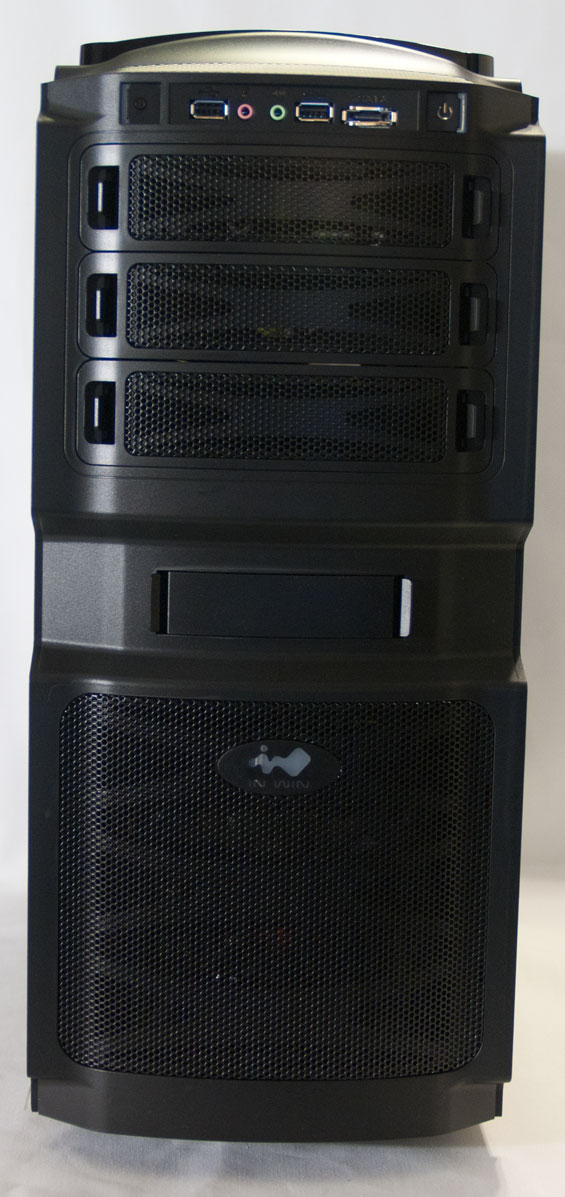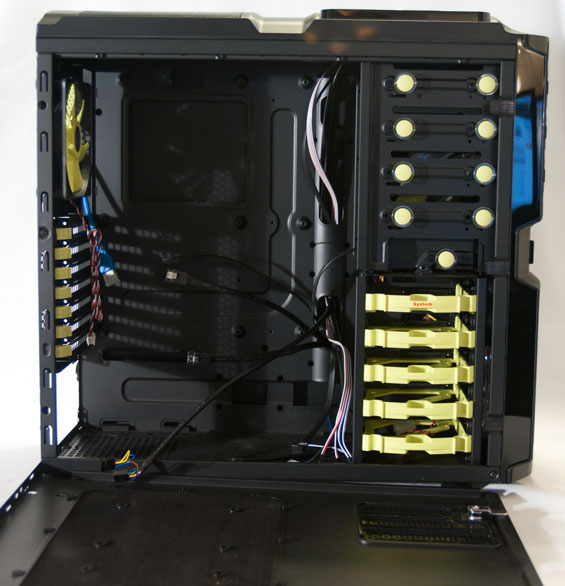IN-WIN BUC: Just How Much $100 Can Buy
by Dustin Sklavos on May 9, 2011 4:28 PM EST- Posted in
- Cases/Cooling/PSUs
- In-Win
- mid-tower
In and Around the IN-WIN BUC
I'll come out and say it: while I don't think it's anywhere near as ostentatious as a lot of gaming-oriented cases can be, the IN-WIN BUC could probably stand a little more understatement. There's no glossy plastic to be found anywhere on this chassis except for a light trim at the top and small side accents, though, and thankfully the lighting is in no way overpowering: the front logo glows red (this can be disabled), and the front fan glows blue. The color scheme is two-toned, with most of the case in black and assembly grommets and trays in a kind of neon yellow-green.
Build materials are the standard plastic and SECC steel one would expect in the price range, but the case feels sturdy and not liable to snap or break anywhere in particular. As we get into this, you'll see places where IN-WIN cut corners to keep costs down and generally speaking they're fairly smart with their approach.

The first thing that struck me when I started playing with the BUC was that it's a largely toolless case design. This is something I think some manufacturers even at the upper end of the field forget we actually appreciate, and what you're going to find is that there's an awful lot of thought given to practicality, ease of use, and flexibility when it comes to this case. The front covers for the 5.25" bays all snap in and out relatively easily, but they're secure enough so they don't rattle and have a squeeze-clamp kind of design that I actually prefer to the drive bay covers I've seen on more expensive cases like Antec's P182/P183 and Corsair's 600T. Practicality is king here.
When you go to open the case up, you'll find that instead of even thumbscrews, IN-WIN has adopted plastic clamps that work surprisingly well. If these aren't to your taste, you can remove them and just use conventional screws/thumbscrews to secure the panels. What I was really pleased with, and a couple of you are going to nod knowingly, is the fact that the side panels slide on and off with a minimum of fuss. I've used a few inexpensive cases where side panels didn't line up quite right or required a lot of force to budge once they were stuck in place.
The main side panel also features ventilation and mounts for two 120mm fans; clearance in the bottom mount is fine for video cards, but there wasn't enough room to put a fan in the top mount with our Zalman CNPS9900 CPU cooler attached. There's a smaller removable piece in the bottom right of the panel that uses a conventional case key; this gives you access to three of the hotswap bays. NewEgg cites the enclosure as having four bays, but that's not entirely true; only the first three can be accessed with the door and the fourth is only accessible if the entire side panel is removed.

Popping open the BUC reveals a largely toolless interior. 5.25" drives are secured by popping out the neon green knobs, sliding the drive in, and then popping the knobs back in--and you only have to do this on the main side of the enclosure. There's a single knob for the external 3.5" bay, and then there are five 3.5" drive trays, four of which connect seamlessly to a SATA backplane.
The motherboard tray has the standoffs for a full ATX board more or less built in, and amen to that. It's been a long time since I've seen a motherboard that uses any kind of nonstandard standoffs, so not having to install those is welcome. Above the motherboard area is an opening where an additional 120mm fan can be installed; two plastic clamps flex open as you insert the fan, and then it more or less locks into place. This felt a little bit loose to me and is definitely vibration prone.
Finally, the expansion bays include one actual removable slot cover, with the rest essentially needing to be bent and snapped off. That's disappointing, but on the bright side each of these have a clamp that rotates outside of the case: no screwing in expansion cards, and our GTX 580 was remarkably secure using these clamps.
















57 Comments
View All Comments
Dustin Sklavos - Tuesday, May 10, 2011 - link
My gaming drive alone is 585GB, and that's all legitimately purchased content.My scratch drive, where I put video I'm editing, has nearly a terabyte of video on it.
My desktop has, on the whole, four hard drives (two in a RAID 1 and two in a RAID 0) and two SSDs (two in a RAID 0).
So no, you don't have to steal content to fill that much space. You can get by just fine by making your own.
dagamer34 - Tuesday, May 10, 2011 - link
You can never have enough hard drives for backups.FSWKU - Tuesday, May 10, 2011 - link
Because anyone who needs a lot of space MUST be stealing content. That's the ONLY possible explanation. Lets see how much space I actually NEED:Windows Folder = 11.8gb
Steam Folder = 17.3gb
Music Folder = 31.3gb (all ripped from CDs that I own)
Disc Images = 20.9gb (several flavors of Linux, Backtrack, and a few versions of Windows downloaded from my TechNet subscription to use in the VMs I develop on.)
Video Folder = 50gb (all projects I've worked on or DVD's that I've backed up from my collection).
Documents Folder = 20.4gb (Pictures, application files, training materials, savegames, misc drivers, voiceover projects, VHDs for the VMs I mentioned earlier)
Thats 151.7gb, and I don't use my computer for nearly as much as most other people do. I keep most of my space free because I dabble in video editing. But this just means my 320gb (297gb once all is said and done) is just barely enough for what I do. But of course I MUST be stealing content if I feel like I need more space than the 80gb you limit yourself to...
Taft12 - Monday, May 9, 2011 - link
<i>There's a lot you can do to mitigate it by using quiet fans and employing fan controls, but it just doesn't have a whole lot to really keep all that noise in and with a video card like the GeForce GTX 580 it might get a little louder than you'd like.</i>Fortunately, a PC case at this price point is unlikely to see a GTX580. A GTX 560 or 6870 is much more likely. This really sounds like the best option for a wide window of PC budgets and it sounds like you'd need to double the price you pay to get a case that is a definitive improvement.
Great review Dustin!
fraginader - Monday, May 9, 2011 - link
Would be nice to have a labelled diagram detailing various terms like 5.25" bay, SATA backplane etc. Newbies like me would appreciate it.micksh - Monday, May 9, 2011 - link
One foot distance for noise measurement is actually too close. Towers are mostly standing on the floor so the distance to ears is rather 3 feet.This results noise from front fan contributing to overall system noise way more than it would contribute from 3 feet distance.
One foot distance to front fan means two feet distance to video card. With doubling the distance noise pressure decreases 4 times.
Let's imagine video card and front fan generate the same amount of noise. This method will result 6 decibel added to front fan noise comparing to video card noise.
Whereas registering sound from 3 feet would make difference in distance negligible and amount of noise would be almost the same from both.
Same thing happened in December in review of Silverstone GD04 case. Sound meter was too close to case fan and the case fan noise was artificially inflated in dBA measurement. And CPU fan noise was suppressed by difference in distance. This resulted incorrect conclusion that the case was loud. If you read Silentpcreview.com review of the same case they regarded GD04 case as quiet. But they measured it from 1 meter and they used very quiet components so their methodology should be more accurate.
And I highly doubt that noise floor in silent apartment at night is 32dB. It's probably sound meter limit.
Better sound meter is needed in order to get accurate readings.
Dustin Sklavos - Tuesday, May 10, 2011 - link
Actually my tower is about two feet at most from my left ear. Some peoples' mileage may vary; I have a friend whose tower is on his desk. The fans in the BUC aren't the issue, and the system runs very quietly at idle from a subjective point of view. The BUC doesn't have much in the way of soundproofing, and that's why noise levels go through the roof when the GTX 580 gets stressed.32dB is actually pretty quiet. I'm sorry I don't live in a quieter area, but you'll also find the rated noise floors for most sound meters $300 and below is between 30 and 40dB.
At the risk of being unprofessional, I'm getting tired of SPCR being brought in here as the bible by which all other reviews must be judged. The GD04, without proper fan control, is audible. SilverStone's engineers will even admit to that, and I think SilverStone tends to engineer their designs towards performance first. Then, when you employ fan control, you find that their cases are so well-engineered that they're able to handle considerable thermal stress without requiring substantial active cooling.
As I told Tony at SilverStone when I met him at CES, I bought the GD04 with my own money, of my own volition, after having explicitly researched the case including your vaunted SPCR review. It was audible even across the room, where I had it stationed next to my television. It NEEDS fan control.
micksh - Tuesday, May 10, 2011 - link
Sure, fan control is needed, I don't argue with that.If a single case is going to be utilized for two scenarios - high performance system and quiet system, it's better to use fan control for quiet scenario.
I'm not questioning this review of BUC case. I'm just pointing that measuring noise so close may offset results in the future, for other reviews.
You just need $2000 sound meter, then you will be all set.
Spivonious - Tuesday, May 10, 2011 - link
Agreed. I'd like to see both 1ft and 3ft measurements. And 32dB noise floor in a nighttime apartment does seem high. I'd expect a level of 20-25dB, unless the meter is under the air conditioning vent, or the neighbors are having a party.JFish222 - Monday, May 9, 2011 - link
I'm not familiar with specific of using sata backplanes but assume they use some form of voltage control and/or bridge chip.Can you go into further details about how this works (ie: if a bridge chip is used, supplier/model) and specify if it supports SATA rev3 (6Gb)?
Thanks for another great article.
- J